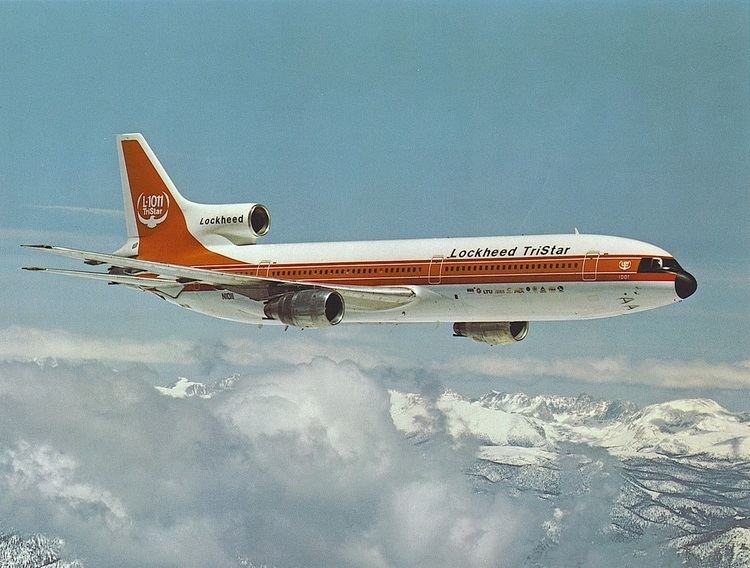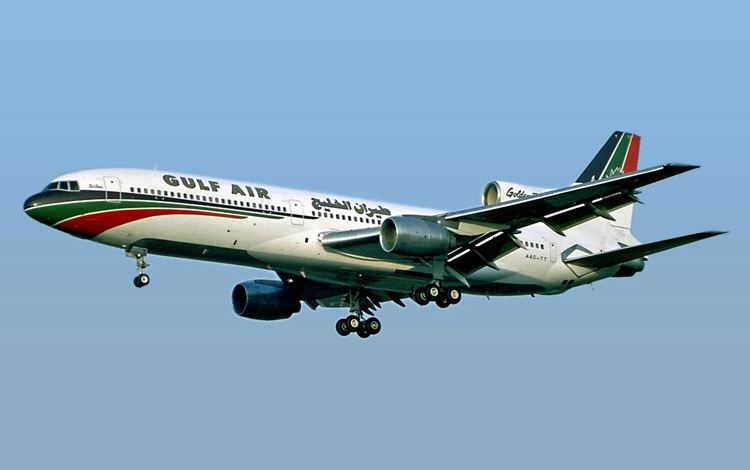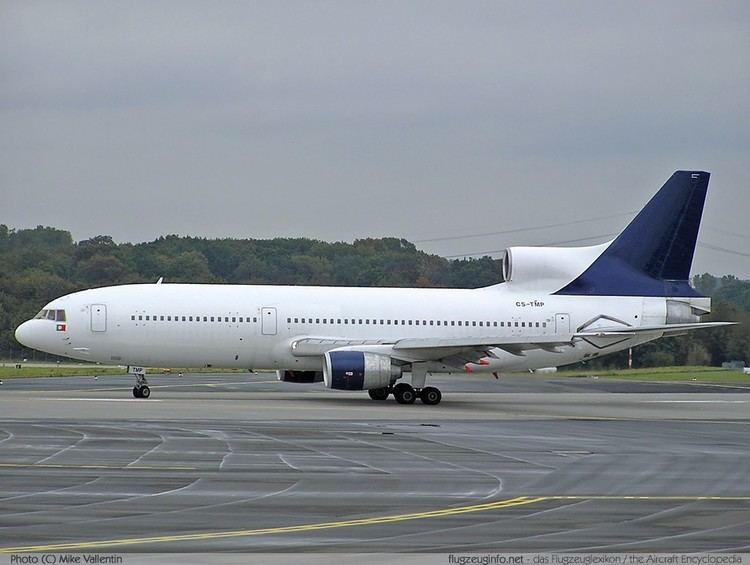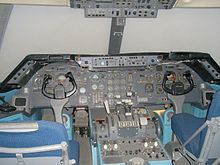Top speed 973 km/h Range 7,410 km Weight 110,000 kg | Cruise speed 890 km/h Length 54 m | |
 | ||
Lockheed l 1011 tristar eastern airlines promotional film 48654
The Lockheed L-1011 TriStar, commonly referred to as the L-1011 (pronounced "L-ten-eleven") or TriStar, is a medium-to-long-range, wide-body trijet airliner by Lockheed Corporation. It was the third wide-body airliner to enter commercial operations, after the Boeing 747 and the McDonnell Douglas DC-10. The airliner has a seating capacity up to 400 passengers and a range over 4,000 nautical miles (7,410 km). Its trijet configuration has three Rolls-Royce RB211 engines with one engine under each wing, and a third engine, center-mounted with an S-duct air inlet embedded in the tail and the upper fuselage. The aircraft has an autoland capability, an automated descent control system, and available lower deck galley and lounge facilities.
Contents
- Lockheed l 1011 tristar eastern airlines promotional film 48654
- Origins
- Production
- Design
- Commercial
- Military
- Other
- Variants
- L 1011 1
- L 1011 100
- L 1011 50
- L 1011 150
- L 1011 200
- L 1011 250
- L 1011 500
- Dimensions
- Flying surfaces
- Powerplant
- Performance
- Cabin
- Operators
- Accidents and incidents
- Notable accidents and incidents
- Aircraft on display
- Specifications
- Popular culture
- References

The L-1011 TriStar was produced in two fuselage lengths. The original L-1011-1 first flew in November 1970, and entered service with Eastern Air Lines in 1972. The shortened, longer range L-1011-500 first flew in 1978, and entered service with British Airways a year later. The original-length TriStar was also produced as the high gross weight L-1011-100, up-rated engine L-1011-200, and further upgraded L-1011-250. Post-production conversions for the L-1011-1 with increased takeoff weights included the L-1011-50 and L-1011-150.

Between 1968 and 1984, Lockheed manufactured a total of 250 TriStars, assembled at the Lockheed plant located at the Palmdale Regional Airport in southern California north of Los Angeles. The aircraft's sales were hampered by two years of delays due to developmental and financial problems at Rolls-Royce plc, the sole manufacturer of the TriStar's engines. After production ended, Lockheed withdrew from the commercial aircraft business due to its below-target sales.

Origins

In the 1960s, American Airlines approached Lockheed and competitor Douglas (later McDonnell Douglas) with the need for an airliner smaller than the 747 capable of carrying a large passenger load to distant locales such as London and Latin America from company hubs at Dallas-Ft Worth and New York. Lockheed had not produced civilian airliners since 1961 with the L-188 Electra. In the 1950s the Electra was designed for turboprop propulsion, which Lockheed had successfully used on the C-130 Hercules military transport. Even after the Electra overcame vibration problems that caused a number of crashes early in its career, the market for large airliners would soon shift over to jet airliners like the Boeing 707 and Douglas DC-8. Lockheed won contracts for jet military transports with the C-141 StarLifter, and pioneered very large jet transports with the large C-5 Galaxy with its high-bypass turbofan engines. Boeing lost the military contract, but its private venture 747 captured what would become a much larger civilian airliner market for wide-body airliners. Having experienced difficulties with some of their military programs, Lockheed was eager to re-enter the civilian market with a smaller wide-body jet, and their response was the L-1011 TriStar. The aircraft was originally conceived as a "jumbo twin", but a three-engine design was ultimately chosen to give the aircraft enough thrust to take off from existing runways.

The design featured a twin-aisle interior with a maximum of 400 passengers, a three-engine layout, low noise emissions (in the early 1970s, Eastern Air Lines nicknamed the L-1011 "WhisperLiner"), improved reliability, and efficient operation. The main visible difference between the TriStar and its similar trijet competitor, the McDonnell Douglas DC-10, is the middle/tail engine: the DC-10's engine is mounted above the fuselage for simplicity of design and more economical construction, while the TriStar's engine is mounted to the rear fuselage and fed through an S-duct (similar to the Boeing 727) for reduced drag, improved stability, and easier replacement. A further major difference between the L-1011 and the DC-10 was Lockheed's selection of the Rolls-Royce RB211 as the only engine for the L-1011. As originally designed, the RB211 turbofan was an advanced three-spool design with a carbon fiber fan, which would have better efficiency and power-to-weight ratio than any competing design. This made the L-1011 more efficient, a major selling point.
The L-1011 and DC-10's engineering approach differed greatly. McDonnell, who had recently taken over Douglas Aircraft, directed DC-10 development on a "very firm budget, and cost overruns were unacceptable – even at the expense of safety", and the conservative approach meant reusing Douglas DC-8 technology. By contrast Lockheed would "take the most advanced technology of the day and when that technology was lacking, Lockheed created it" for the L-1011. The advanced innovation that went into the TriStar resulted in its expensive price as "Airlines could get a 747 for slightly more, or a DC-10 for a good deal less".
American Airlines opted for the Douglas DC-10, although they showed considerable interest in the L-1011. American's intent was to convince Douglas to lower their price for the DC-10, which they did. Without the support of American, the TriStar was launched on orders from TWA and Eastern Air Lines.
Although the TriStar's design schedule closely followed that of its competitor, Douglas beat Lockheed to market by a year due to delays in powerplant development. In February 1971, after massive development costs associated with the RB211, Rolls-Royce went into receivership. This halted L-1011 final assembly and Lockheed investigated the possibility of a US engine supplier; by then it was considered too late to change engine suppliers. One option presented was potential outsource of RB-211 production to Canadian manufacturer Orenda Engines.
The British government agreed to approve a large state subsidy to restart Rolls-Royce operations on condition the U.S. government guarantee the bank loans Lockheed needed to complete the L-1011 project. Despite some opposition, not least from the then Governor of California, Ronald Reagan, the U.S. government provided these guarantees. For the rest of the RB211 project, Rolls-Royce remained a government-owned company.
Production
The TriStar's internal Lockheed model number is L-093. The TriStar was manufactured in Lockheed facilities in Burbank and Palmdale, California.
Lockheed discovered fairly early on that the TriStar suffered from higher than estimated structural weight, engine weight, and specific fuel consumption. To rectify this problem and to meet performance guarantees, Lockheed developed a structural kit that allowed maximum takeoff weight (MTOW) to be increased on production aircraft from 409,000 to 430,000 pounds (186,000 to 195,000 kg). However, the weight problems affected the weight and desirability of early production L-1011-1 aircraft, known as Group 1 (msn 1002 through to 1012).
Group 1 aircraft have on OEW of 252,700 pounds (114,600 kg), about 12,700 pounds (5,800 kg) higher than later aircraft, while Group 2 aircraft (msn 1013 through 1051) have an OEW of 247,000 pounds (112,000 kg), some 4,700 pounds (2,100 kg) lower. These aircraft, in general, also have different center of gravity envelopes with the forward center of gravity limit on the early aircraft being more restrictive at higher gross weights. Groups 1 and 2 aircraft (msn 1002 to 1051) are upgradeable only to -50 or -150 specifications, although the Group 1 aircraft (up to msn 1012) still maintain their operating disadvantages. L-1011-1 from msn 1052 onwards are Group 3 aircraft and are fully upgradeable to all variants up to -250 specification.
Under state control, costs at Rolls-Royce were tightly controlled and their efforts largely went into the original TriStar engines, which needed considerable modifications between the L-1011's first flight and service entry. The competition, notably General Electric, was very quick to develop their CF6 engine with more thrust, which meant that a heavier "intercontinental" DC-10-30 could be more quickly brought to market. The flexibility afforded to potential customers by a long-range DC-10 put the L-1011 at a serious disadvantage. Rolls-Royce went on to develop the high-thrust RB211-524 for the L-1011-200 and -500, but this took many years.
The resultant delay in Lockheed and Rolls-Royce offering a high gross variant with a longer range, coupled with the TriStar's delayed introduction, meant that only 250 TriStars were sold compared to some 400 DC-10s. Lockheed needed to sell 500 airliners to break even, but in 1981, the company announced production would end with delivery of the 250th and last L-1011 on order in 1984.
The TriStar's failure to achieve profitability caused Lockheed to withdraw from the civilian aircraft business. The TriStar's rivalry with the DC-10 has been seen as a "case study in what can happen when two manufacturers attempt to split a market that simply could not support both aircraft". Lockheed lacked the resources to follow up with several proposals based on the TriStar wing and airframe, including a wide-body twinjet and a stretched quad-jet (two underwing engines and two rear fuselage mounted engines). McDonnell-Douglas was also financially weakened and could only develop the MD-11, a refinement of the DC-10, instead of an all-new design to challenge the next generation of twinjets like the Boeing 777, and the MD-11's failure led to McDonnell-Douglas ceasing further civilian aircraft development and merging with Boeing.
Design
The L-1011 featured a highly advanced autopilot system and was the first widebody to receive FAA certification for Cat-IIIc autolanding, which approved the TriStar for completely blind landings in zero-visibility weather performed by the aircraft's autopilot. The L-1011 used an inertial navigation system to navigate; this included aligning the navigation system by entering current coordinates of longitude and latitude.
It also had a unique direct lift control (DLC) system, which allowed for smooth approaches when landing, without having to use significant pitch changes while on the approach path. DLC helps maintain the descending glideslope on final approach by automatically deploying spoiler panels on the wings. Thus, rather than maintaining the descent by adjusting pitch, DLC helps control the descent while maintaining a more consistent pitch angle, using four redundant hydraulic systems. Production also used a unique "autoclave" system for bonding fuselage panels together; this made the L-1011 extremely resistant to corrosion.
Commercial
The prototype first flew on November 17, 1970. The crew for that flight was H. B. Dees (pilot), Ralph C. Cokely (copilot), and G.E. Fisher (development engineer). The L-1011 was certified on April 14, 1972, with the first airliner delivered to Eastern Air Lines on April 26, 1972. To further publicize the new aircraft, an L-1011 was taken on a world tour during 1972 by famed Lockheed test pilot Tony LeVier. In a demonstration by test pilots Anthony LeVier and Charles Hall, 115 crew members, employees, and reporters embarked on the TriStar for a 4-hour, 13- minute flight from Palmdale to Dulles Airport "with the TriStar’s AFCS feature engaged from takeoff roll to landing", and Lockheed touted it as "a groundbreaking moment: the first cross-country flight without the need for human hands on the controls".
TWA heralded the TriStar as one of the safest aircraft in the world in promotional literature in the 1980s when concern over the safety record of the McDonnell Douglas DC-10, flown by rival airlines, was at its peak. The L-1011 has been involved in five fatal accidents, only one of which was due to a problem with the aircraft.
Delta Air Lines was the type's largest customer. Delta retired its TriStars in 2001 to replace them with the Boeing 767-400ER. Cathay Pacific eventually became the largest non-U.S. operator of the type by acquiring many of the Eastern Air Lines examples when Eastern went bankrupt, operating as many as 21 aircraft. Cathay Pacific retired its L-1011s in October 1996, and replaced the type with the Airbus A330-300. TWA withdrew its last TriStar from service in 1997.
To secure the Japanese market, Lockheed secretly bribed several members of the Japanese government to subsidize All Nippon Airways' purchase of L-1011s; this caused a significant scandal when the bribes were uncovered. The discovered scale to what has become known as the Lockheed bribery scandal led to the arrest of Japanese Prime Minister Kakuei Tanaka, as well as several other officials. Within Lockheed, board chairman Daniel Haughton and vice chairman and president Carl Kotchian resigned their posts on February 13, 1976. Tanaka was eventually tried and found guilty of violating foreign exchange control laws, but was not charged with bribery, a more serious criminal offense. Crucially for Lockheed, the fallout from the scandal included the loss of a contract worth in excess of $1 billion.
The Soviet Union at that time lacked a widebody airliner. Development of their own Ilyushin Il-86 was delayed; consequently, in the mid-1970s, the Soviets started negotiations to buy 30 TriStars and licence-produce up to 100 a year. The talks collapsed as US President Jimmy Carter made human rights a US policy factor. The TriStar was also listed by the Coordinating Committee as embodying advanced technology banned from potential enemies, thus being a serious obstacle to the export deal.
The L-1011 has had recent use by smaller start-up carriers, particularly in Africa and Asia. These operators mainly do their business in the ad hoc charter and wet leasing businesses. ATA Airlines (formerly known as American Trans Air) fleet included over 19 Tristars, but operations dwindled to only three L1011-500s prior to the company's shutdown in April 2008.
Military
The TriStar has also been used as a military tanker and passenger/cargo aircraft. The Royal Air Force had nine aircraft of four variants. The aircraft were six ex-British Airways and three Pan Am L-1011-500s. All of the aircraft served with No. 216 Squadron, and were based at RAF Brize Norton. The Tristar was replaced in RAF service by the Airbus A330 MRTT under the Future Strategic Tanker Aircraft program. 216 Squadron was officially disbanded on 20 March 2014 and flew its last sorties with the TriStar on 24 March 2014.
Other
In the early 1990s, Orbital Sciences began to use a converted L-1011-100 named Stargazer to launch Pegasus rockets into orbit around Earth. This venture effectively rendered the small Scout rocket obsolete. This aircraft was also used in support of the X-34 and X-43 programs. NASA performed aerodynamic research on Orbital Sciences' L-1011 in 1995. As of 2014, three L-1011s in the world are airworthy, and the Stargazer is the only one in the US.
Variants
The earlier versions of the L-1011, such as the -1, -100, and -150 can be distinguished from the later models by the design of the middle engine nacelles. The earlier version nacelle has a round intake, whereas the later models have a small vertical fin between the bottom of the middle engine intake and the top of the fuselage.
The two L-1011 aircraft delivered to Pacific Southwest Airlines were configured with internal airstair doors that led into an entry hall in what was normally the forward lower baggage hold. This was to allow operations from airfields that did not have terminal buildings with jet bridges. These two aircraft were later in service with Aeroperú and Worldways Canada.
L-1011-1
The L-1011-1 (FAA certification L-1011-385-1) was the first production model of the L-1011, designed for short- and medium-range flights. This variant served as the basis for subsequent variants. This type was purchased by Air Canada, ANA, Cathay Pacific, Eastern, and other operators with regional trunk routes requiring a widebody aircraft. Pacific Southwest Airlines purchased two L-1011-1 models with lower deck seating. This variant was also one of the few widebodies to have the option for a full-height built-in airstair.
The L-1011-1 was first delivered to Eastern Air Lines on April 5, 1972. A total of 160 L-1011-1 TriStars were built before production ended in 1983, although the majority of these, 119 or 75% of the total, were completed during a four-year period between 1972 and 1975. Most sales of the L-1011-1 were to US operators, with just three airlines, Delta, Eastern, and TWA, taking delivery of 110 combined. A further two aircraft were placed with a fourth US airline, Pacific Southwest Airlines.
L-1011-100
The L-1011-100 (FAA certification L-1011-385-1-15) was the second production model of the L-1011 and first flew in 1975 and featured a new center fuel tank and higher gross weights that increased the aircraft's range by nearly 930 miles (1,500 km). Launch orders for the L-1011-100 were placed by Saudia and Cathay Pacific, for two each, in May 1974. First deliveries took place in June 1975.
The variant was also purchased by several airlines with longer-range routes, such as TWA, Air Canada, and BEA (which merged with BOAC to form British Airways). The first two L-1011-100s (msn 1110 and 1116) were delivered new to Saudia with the same fuel capacity as the L-1011-1 (FAA certification L-1011-385-1-14); these were later upgraded to L-1011-200 specification.
L-1011-50
The L-1011-50 was an upgraded version of the L-1011-1 with an increase in maximum takeoff weight from 430,000 pounds (195,000 kg) to either 440,000 pounds (200,000 kg) or 450,000 pounds (204,000 kg). Fuel capacity was not increased. The -50 was available only as a conversion package for the L-1011-1 and was never built new.
L-1011-150
The L-1011-150 was a development of the L-1011-1 with its maximum takeoff weight increased to 470,000 pounds (210,000 kg). It was available only as a conversion for the L-1011-1. The -150 involves the conversion of Group 1 and Group 2 L-1011-1 aircraft to an MTOW of 470,000 pounds (210,000 kg), an increase of 40,000 pounds (18,000 kg), about 10%, from the L-1011-1, giving the aircraft a slightly better range than the -50, but without the additional center-section fuel tank, less than the L-1011-100 aircraft. The first aircraft was converted by MBB at Lemwarder in Germany during the winter of 1988/89 and was subsequently handed over to Air Transat of Canada on May 11, 1989.
L-1011-200
The L-1011-200 (FAA certification L-1011-385-1-15), the third production model of the L-1011, was introduced in 1976. Although otherwise similar to the -100, the -200 uses Rolls-Royce RB.211-524B engines to improve its performance in hot and high-altitude conditions. Gulf Air used -200 models to replace its earlier-generation Vickers VC-10 fleet.
Other than the engines, the basic TriStar -200 is identical to the -100, with center-section fuel, having a MTOW of 466,000 pounds (211,000 kg), and fuel capacity of 26,400 US gallons (100,000 l) as the -100. An increase of gross weight to 474,000 pounds (215,000 kg) is possible, with the heavier aircraft offered by Lockheed as -200I or -200(Improved). Saudi Arabian Airlines (Saudia) was a launch customer for the -200 series and operated a sizable fleet until 1998. A total of 24 L-1011-200 aircraft were built new, with the first delivered to Saudia on May 28, 1977. Like other TriStar improvements, a conversion program has also been offered.
L-1011-250
The L-1011-250 was an upgrade developed for late-model L-1011-1 aircraft and all L-1011-100 and L-1011-200 aircraft. It increased maximum takeoff weight to 510,000 pounds (230,000 kg) and fuel capacity from 23,600 US gal (89,335 l) to 31,632 US gal (119,735 l). This variant also used the upgraded RB211-524B4I engine, which could be easily upgraded on the existing RB211-524B powerplants of the L-1011-200, but required a re-engining on the L-1011-1 and L-1011-100, which used the original RB211-22B. The upgrade allowed the L-1011 to match the performance of the long-range McDonnell Douglas DC-10-30. Although it was applicable to all L-1011 models, it was only used by Delta on six late-model L-1011-1 aircraft.
L-1011-500
The L-1011-500 (FAA certification L-1011-385-3) was the last L-1011 variant to enter production. It was a longer-range variant first flight tested in 1978. Its fuselage length was shortened by 14 feet (4.3 m) and MTOW increased to allow higher fuel loads. It also uses the more powerful engines of the -200 series. The -500 variant was popular among international operators and formed a significant portion of the L-1011 fleet of Delta and British Airways. However, its late introduction resulted in many potential customers buying the DC-10-30, instead.
The TriStar 500 first flew on October 16, 1978, with the first delivery to British Airways on April 27, 1979. It entered service with British Airways on May 7, 1979, flying between London and Abu Dhabi.
Dimensions
The TriStar 500 has an overall length of 164 feet 2 inches (50.04 m) and wingspan increased to 164 feet 4 inches (50.09 m) (early TriStar versions originally had the TriStar 1 wing with a span of 155 feet 4 inches (47.35 m)).
Flying surfaces
Lockheed developed some aerodynamic improvements for the TriStar 500 which included a modified wing-to-body fairing, a fillet below the central intake, extended wingtips, and "active ailerons" or active control system (ACS). The new fairing reduced drag, while the fillet reduced noise in the rear cabin. The wingtip extensions increased aspect ratio, thus reducing induced drag, but resulted in increased bending. The ACS, developed to solve this, provided gust alleviation, improving ride during flight, reduced fuel burn, and increased fatigue life.
Earlier TriStar 500s were delivered with the standard wing; these were later retrofitted with ailerons and extended wingtips. Pan Am was the first customer to order the -500 with the extended wingtips and active ailerons. Msn 1176, the first for Pan Am, was the first TriStar 500 to be fitted with them as standard.
Powerplant
The TriStar 500 is equipped with the more powerful RB211-524B engines. Initially rated at 50,000 lbf (220 kN) thrust each, the higher-thrust 53,000 lbf (240 kN) -524B4 Improved (also referred to as the -524B4I) later became available, which also offered improved fuel efficiency.
Performance
Originally certified with an MTOW of 496,000 pounds (225,000 kg), an increased MTOW of 504,000 pounds (229,000 kg) was later certified in 1979, and all earlier production aircraft were certified at this weight. A further increase, to 510,000 pounds (230,000 kg), is also available, and most TriStar 500s are thought to have had this increase. Standard fuel capacity is 31,600 US gallons (120,000 l), giving the TriStar 500 a range of about 5,200 nautical miles (9,600 km) with 246 passengers and baggage.
Cabin
The TriStar 500's maximum passenger capacity is 315, although no aircraft were operated with that number of seats. A typical two-class layout might include 21 first and 229 economy for a maximum of 250 passengers. More spacious three-class layouts used on longer routes include 233 with 12 first, 32 business, and 189 economy with Delta Air Lines. The aircraft is equipped with six exits, two fewer than the long-body TriStars, thus reducing the exit limit maximum.
Operators
Lockheed L-1011 TriStars in service as of 2016:
Accidents and incidents
As of December 2011, the L-1011 was involved in 32 aviation occurrences, including 11 hull-loss accidents, with 539 fatalities.
Of the four pioneering widebody aircraft (Boeing 747, McDonnell Douglas DC-10, L-1011, and Airbus A300/A310 family), the Lockheed L-1011 had comparatively few accidents and a better safety record than its competitors.
Notable accidents and incidents
Aircraft on display
Specifications
Sources: Jane's All The World's Aircraft 1982–83 except where stated
